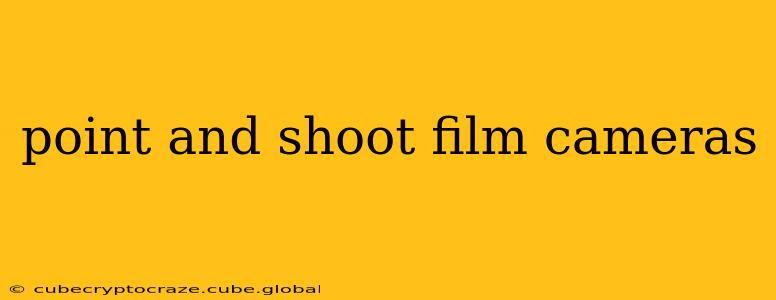The satisfying click of the shutter, the anticipation of developing the film, the unique aesthetic of grain – point-and-shoot film cameras offer a tangible connection to photography that digital just can't replicate. More than just a nostalgic hobby, these compact cameras are experiencing a resurgence, appealing to both seasoned photographers and curious newcomers. This guide dives deep into the world of point-and-shoot film cameras, exploring their history, benefits, and how to choose the perfect one for you.
What is a Point and Shoot Film Camera?
Point-and-shoot film cameras are compact, easy-to-use cameras designed for casual photography. Unlike their more complex SLR counterparts, they typically feature automatic exposure settings, simplifying the process for beginners. The "point and shoot" moniker reflects their straightforward operation: point the camera at your subject and shoot! They're known for their portability and user-friendliness, making them ideal for everyday snapshots and capturing spontaneous moments.
Why Choose a Point and Shoot Film Camera in the Digital Age?
In a world dominated by megapixels and instant digital gratification, the enduring appeal of point-and-shoot film cameras might seem surprising. However, several factors contribute to their continued popularity:
- Unique Aesthetic: Film possesses a distinct look and feel, characterized by its grain, subtle color variations, and often a softer focus. This unique aesthetic is highly sought after by many photographers, lending a certain charm and character to images that digital often struggles to replicate.
- Mindful Photography: The limited number of shots per roll encourages a more deliberate approach to photography. You'll think more carefully about each composition and moment, leading to more thoughtful and meaningful images.
- Tangible Experience: There's a tactile satisfaction to loading film, winding the camera, and anticipating the results. The entire process is more engaging and less instantaneous than digital photography, fostering a deeper connection to the craft.
- Affordability: Many excellent point-and-shoot film cameras can be found at relatively low prices, making them an accessible entry point to the world of film photography.
What are the Different Types of Point and Shoot Film Cameras?
The market offers a diverse range of point-and-shoot film cameras, catering to various needs and preferences. Some key distinctions include:
- 35mm vs. 110/126: While 35mm is the most common format, you can also find cameras using smaller formats like 110 and 126. These offer unique characteristics and are often more compact, but film is less readily available.
- Automatic vs. Manual: Most point-and-shoots are automatic, simplifying exposure settings. However, some offer manual controls allowing for greater creative freedom.
- Features: Consider additional features such as built-in flash, self-timer, macro capabilities, and different lens focal lengths.
How Do I Choose the Right Point and Shoot Film Camera for Me?
Selecting the perfect point-and-shoot depends on your experience level, budget, and photographic goals. Consider these factors:
- Budget: Prices range from very affordable to quite collectible.
- Features: Prioritize the features you'll actually use. Do you need a built-in flash? Is a macro mode important?
- Film Format: 35mm is the most widely available and versatile format.
- Ease of Use: Choose a camera with intuitive controls, especially if you're a beginner.
What Film Should I Use with My Point and Shoot Film Camera?
Choosing the right film is crucial for achieving the desired look. Popular options include:
- Kodak Gold 200: A versatile, readily available film ideal for everyday shooting.
- Fuji Superia X-Tra 400: Another popular choice known for its vibrant colors and good grain.
- Ilford HP5 Plus 400: A black and white film favored for its detail and contrast.
How Much Does it Cost to Use a Point and Shoot Film Camera?
The cost varies depending on the camera, film type, and development method. However, expect to budget for the cost of the camera itself, film rolls (around $5-$15 per roll), and developing and scanning (around $10-$20 per roll).
Where Can I Develop My Point and Shoot Film?
Many local photo labs offer film developing services. Alternatively, mail-order services provide convenient processing and scanning options.
Are Point and Shoot Film Cameras Worth It?
Absolutely! Point-and-shoot film cameras offer a unique photographic experience that digital simply cannot replicate. They're a gateway to a more mindful, tangible, and aesthetically rewarding form of photography. The initial investment and ongoing costs are manageable, making them a worthwhile addition to any photography enthusiast's toolkit. The unique aesthetic and deliberate nature of shooting film offer something profoundly different, enriching the creative process in ways digital cameras rarely can.
